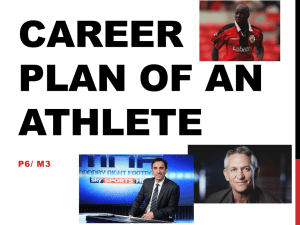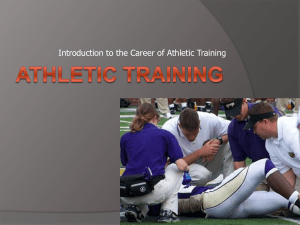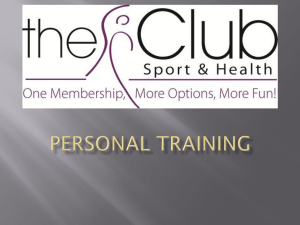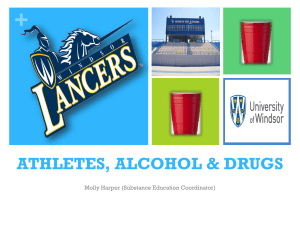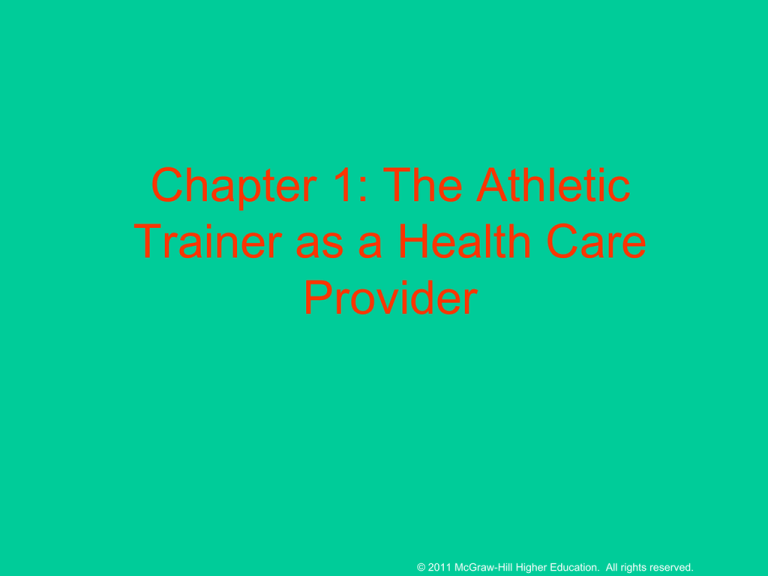
Chapter 1: The Athletic
Trainer as a Health Care
Provider
© 2011 McGraw-Hill Higher Education. All rights reserved.
• Athletic trainers specialize in preventing,
recognizing, managing and rehabilitating
injuries
• Function as a member of a health care
team which also incorporates and
involves a number of medical specialties
• Provide a critical link between the
medical community and physically active
individuals
© 2011 McGraw-Hill Higher Education. All rights reserved.
Changing Face of Athletic
Training Profession
• Role of the athletic trainer is more in line,
today, as a health care provider
– 40% of athletic trainers are employed in
clinics, hospitals, industrial and
occupational settings
– Also involved in NASCAR, performing arts,
military, NASA, medical equipment & sales,
law enforcement, and the US government
• Has resulted in changes in athletic training
education
© 2011 McGraw-Hill Higher Education. All rights reserved.
• Athletic trainers do not just provide
medical care to athletes or those just
injured during physical activity
• Becoming more aligned as a clinical
health care profession
– Requires terminology changes
• Patients and clients vs. athletes
• Athletic clinic or facility vs. athletic training room
• Athletic trainers – NOT TRAINERS!!
© 2011 McGraw-Hill Higher Education. All rights reserved.
Sports Medicine and Athletic
Training
• Broad field of medical practices related
to physical activity and sport
• Involves a number of specialties
involving active populations
• Typically classified as relating to
performance enhancement or injury
care and management
© 2011 McGraw-Hill Higher Education. All rights reserved.
Human
Performance
Injury
Management
Exercise Physiology
Practice of Medicine
Biomechanics
Sport Psychology
Athletic Training
Strength Conditioning
Sports Massage
Personal Fitness
Trainers
Sports Podiatry/
Orthotists
Sports Physical Therapy
Sports Dentistry
© 2011 McGraw-Hill Higher Education. All rights reserved.
Employment Settings for the
Athletic Trainer
• Employment opportunities are
becoming increasingly diverse
– Dramatic transformation since 1950
– Due largely to the efforts of the NATA
• Started out primarily in the collegiate
setting, progressed to high schools and
are now 30% are found primarily in
hospital and clinic settings
© 2011 McGraw-Hill Higher Education. All rights reserved.
• Settings include:
–
–
–
–
–
–
–
–
–
–
–
–
Clinics and hospitals
Physician extenders
Industrial/Occupational settings
Corporate settings
Colleges or Universities
Secondary schools
School districts
Professional sports
Amateur/Recreational/Youth sports
Performing arts
Military & Law enforcement
Health & fitness clubs
© 2011 McGraw-Hill Higher Education. All rights reserved.
Roles & Responsibilities of the
Athletic Trainer
• Charged with injury prevention and
health care provision for an injured
patient
• Athletic trainer deals with the patient
and injury from its inception until the
athlete returns to full competition
© 2011 McGraw-Hill Higher Education. All rights reserved.
Roles and Responsibilities:
Board of Certification Domains
•
•
•
•
Prevention
Clinical evaluation and diagnosis
Immediate care
Treatment, rehabilitation and
reconditioning
• Health care administration
• Professional responsibilities
© 2011 McGraw-Hill Higher Education. All rights reserved.
• Prevention
– Ensure safe environment
– Conduct pre-participation physicals
– Develop training and conditioning
programs
– Select and fit protective equipment
properly
– Explaining important diet and lifestyle
choices
– Ensure appropriate medication use while
discouraging substance abuse
© 2011 McGraw-Hill Higher Education. All rights reserved.
• Clinical Evaluation & Diagnosis
– Recognize nature and extent of injury
– Involves both on and off-field evaluation
skills and techniques
– Understand pathology of injuries and
illnesses
– Referring to medical care
– Referring to supportive services
• Immediate Care
– Administration of appropriate first aid and
emergency medical care (CPR, AED)
– Activation of emergency action plans
(EAP)
© 2011 McGraw-Hill Higher Education. All rights reserved.
• Treatment, Rehabilitation Reconditioning
–
–
–
–
Design preventative training systems
Rehabilitation program design
Supervising rehabilitation programs
Incorporation of therapeutic modalities and
exercise
– Offering psychosocial intervention
• Organization & Administration
–
–
–
–
Record keeping
Ordering supplies and equipment
Establishing policies and procedures
Supervising personnel
© 2011 McGraw-Hill Higher Education. All rights reserved.
• Professional Responsibilities
–
–
–
–
Athletic trainer as educator
Athletic trainer and continuing education
Athletic trainers as counselor
Athletic trainers as researcher
• Incorporation of evidence medicine and
participating and acquisition of evidence for
efficacy of patient care
© 2011 McGraw-Hill Higher Education. All rights reserved.
The Athletic Trainer and the
Team Physician
• Athletic trainer works under direct
supervision of physician
• Physician assumes a number of roles
– Serves to advise and supervise ATC
• Physician and the athletic trainer must be
able to work together
– Have similar philosophical opinions
regarding injury management
• Helps to minimize discrepancies and
inconsistencies
© 2011 McGraw-Hill Higher Education. All rights reserved.
• The physician is responsible for
compiling medical histories and
conducting physical exams
– Pre-participation screening
• Diagnosing injury
• Deciding on disqualifications
– Decisions regarding athlete’s ability to
participate based on medical knowledge
and psychophysiological demands of sport
• Attending practice and games
• Commitment to sports and athlete
© 2011 McGraw-Hill Higher Education. All rights reserved.
The Athletic Trainer and
the Coach
• Must understand specific role of all
individuals involved with the team
• Coach must clearly understand the
limits of their ability to function as a
health care provider in their respective
state
• Directly responsible for injury prevention
– Athlete must go through appropriate
conditioning program
© 2011 McGraw-Hill Higher Education. All rights reserved.
• Coach must be aware of risks
associated with sport
• Provide appropriate training and
equipment
• Should be certified in CPR and first aid
• Must have thorough knowledge of
skills, techniques and environmental
factors associated with sport
• Develop good working relationships with
staff, including athletic trainers
– Must be a cooperative relationship
© 2011 McGraw-Hill Higher Education. All rights reserved.
Referring the Patient to
Other Personnel
• The athletic trainer must be aware of
available medical and non-medical personnel
– Patient may require special treatment outside
of the “traditional” sports medicine team
• Must be aware of community based services
and various insurance plans
– Typically the athletic trainer and team
physician will consult on the particular matter
and refer accordingly
© 2011 McGraw-Hill Higher Education. All rights reserved.
Sports Medicine Team
•
•
•
•
•
•
•
•
•
•
•
Physicians
Dentist
Podiatrist
Nurse
Physicians Assistant
Physical Therapist
Occupational Therapist
Massage Therapist
Ophthalmologist
Dermatologist
Gynecologist
•
•
•
•
•
•
Exercise Physiologist
Biomechanist
Nutritionist
Sport Psychologist
Coaches
Strength & Conditioning
Specialist
• Social Worker
• Neurologist
• Emergency Medical
Technician
© 2011 McGraw-Hill Higher Education. All rights reserved.
Accredited Athletic Training
Education Programs
• Entry-level athletic training education
programs
– In 2009, 357 undergraduate programs, 19
entry-level master’s programs
• Advanced graduate athletic training
education programs
– Designed for individuals that are already
certified ATs
© 2011 McGraw-Hill Higher Education. All rights reserved.
Athletic Training Education
Competencies
• Twelve Content Areas
– Risk management
– Pathology of injuries and illnesses
– Orthopedic clinical examination & diagnosis
– Acute care
– Pharmacological aspects of injury and illness
– Therapeutic modalities
© 2011 McGraw-Hill Higher Education. All rights reserved.
Athletic Training Education
Competencies
– Conditioning & rehabilitative exercise
– General medical conditions and disabilities
– Nutritional aspects of injury and illnesses
– Psychosocial intervention and referral
– Health care administration
– Professional development &
responsibilities
© 2011 McGraw-Hill Higher Education. All rights reserved.
• Foundational Behaviors of Professional
Practice
– “People” components of the profession
• Recognizing the primary focus of practice
should be the patient
• Understanding that competent health care
requires a team approach
• Being aware of legal elements of practice
• Practicing ethically
• Advancing the knowledge base in athletic
training
• Appreciate cultural diversity
• Being an advocate and model for the AT
profession
© 2011 McGraw-Hill Higher Education. All rights reserved.
Post-Professional Athletic
Training Education Programs
• 15 programs are certified by the NATA
Graduate Education Committee
• Designed to enhance academic and
clinical preparation of already certified
athletic trainers
© 2011 McGraw-Hill Higher Education. All rights reserved.
Requirements for Certification
as an Athletic Trainer
• Must have extensive background in
formal academic preparation and
supervised practical experience
• Guidelines are set by the Board of
Certification (BOC)
© 2011 McGraw-Hill Higher Education. All rights reserved.
• Upon meeting the educational
guidelines applicants are eligible to sit
for the examination
• Examination is computer based
• Exam assesses the 6 domains
–
–
–
–
–
–
Prevention
Evaluation and diagnosis
Immediate care
Treatment, rehabilitation & reconditioning
Organization and administration
Professional responsibility
© 2011 McGraw-Hill Higher Education. All rights reserved.
• Upon passing the certification
examination = BOC certified as an
athletic trainer
– Credential of ATC
• BOC certification is a prerequisite for
licensure in most states
© 2011 McGraw-Hill Higher Education. All rights reserved.
Continuing Education
Requirements
• Ensure ongoing professional growth
and involvement
• Requirements that must be met to
remain certified
– 75 CEUs over the course of three years
© 2011 McGraw-Hill Higher Education. All rights reserved.
Future Directions for the
Athletic Trainer
• Will be determined by the efforts of the
NATA and its membership
– Ongoing re-evaluation, revision and reform of
athletic training education
– Further recognition of CAATE by CHEA will
further enhance credibility
– Athletic trainers must continue to actively seek
third party reimbursement for athletic training
services
– Standardization of state practice acts
© 2011 McGraw-Hill Higher Education. All rights reserved.
– Athletic trainers will seek specialty
certifications
• Expanding breadth and scope of practice
– Increase in secondary school employment of
athletic trainers
– Increase in recognition of athletic trainers as
physician extender
– Potential for expansion in the military, industry,
and fitness/wellness settings
– With general population aging = increased
opportunity to work with aging physically
active individuals
– Continue to enhance visibility through
research and scholarly publication
© 2011 McGraw-Hill Higher Education. All rights reserved.
– Continue to be available for local and
community meetings to discuss health care
of the athlete
– Increase recognition and presence
internationally
– Most importantly, continue to focus efforts
on injury prevention and to provide high
quality health care to physically active
individuals regardless of the setting in
which the injury occurs
© 2011 McGraw-Hill Higher Education. All rights reserved.


